06_BIOFABRICATING MATERIALS¶
A collaborative works by Ruby Lennox, Maria-Rigina Chatzivalasi, Julija Karas, Hala Amer, and ChungHan Lu with mentorship from Petra and Julia.
_What and how?¶
| Bioplastic | a biobased polymer desived from a biomass. It is comprised of a biopolymer, plasticizer, and a solvent. |
| Polymer | assemblies of identical chemical subunits, called monomers, that are linked together in the form of a chain. |
| Biobased | Made of bacteria, fungi, mineral, vegetal, biosyntehtic, and animal. |
| Biodegradable | Degrades in specific conditions like pH sensitive environments, thermo sensitive, and enzymes. |
| Biocompostable | composted in 90 days like bacteria, mycelium, animals, etc. |
| Crafted | Casted, extruded, and/or assembled. |
| Grown | from scratch like fingii, microbial, and lab grown leathers. |
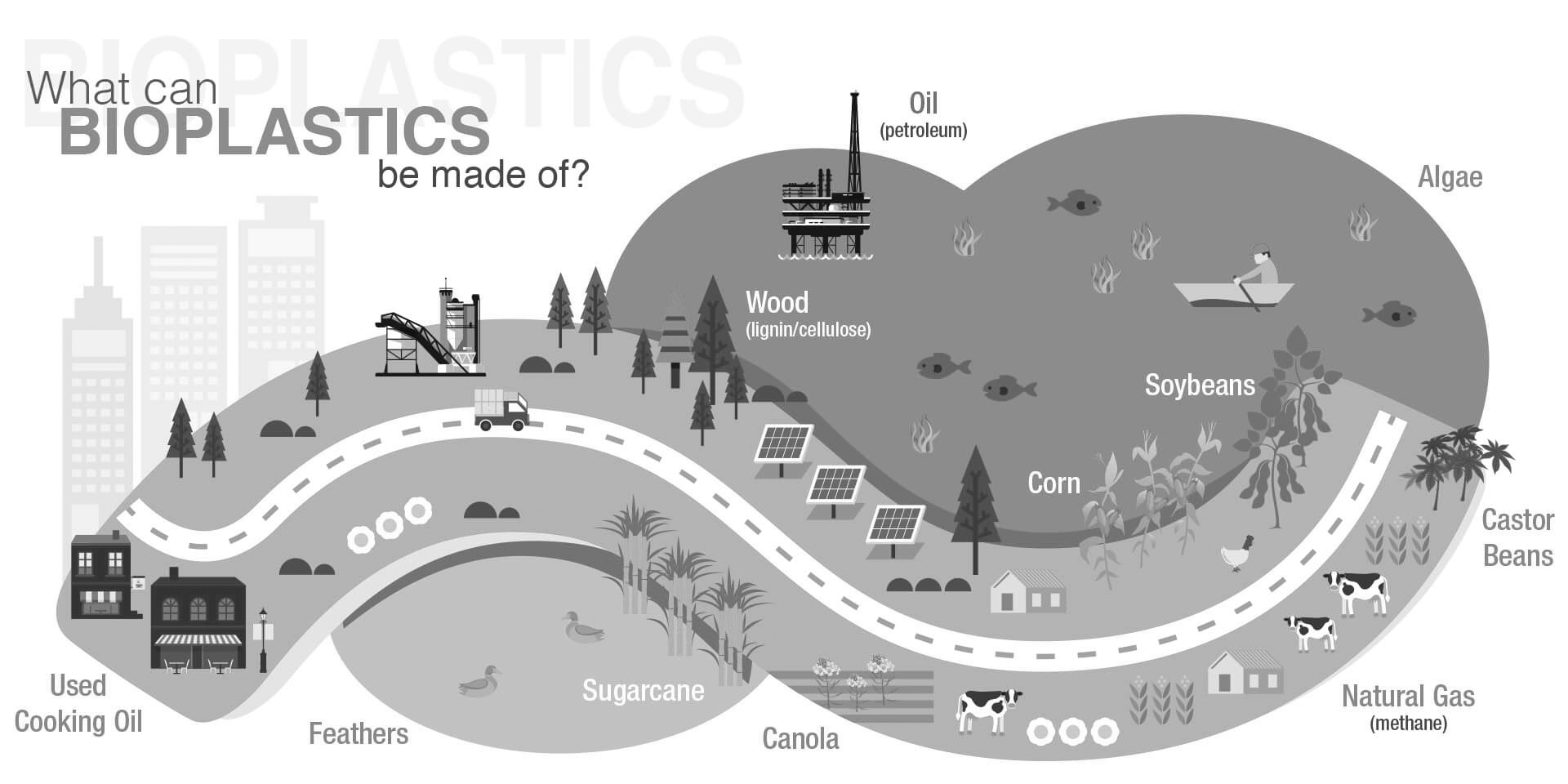
| Plastics | Bioplastics | |
| Polymer | Polymer | Alginate, gelatine, starch, etc |
| Plasticizer | to create flexibility | glycerine (the more glycerine the more elastic but never exceed the 1:1 ration) |
| Filler | to avoid shrinkage | any waste like egg shells, chalk, fibers, oils, etc |
| Stiffening | agent for structure and reinforcement | fibers and natural debri, roots, plant matter |
| Expanding | agent to create foams | green soaps and emulsifiers (waste water of canned chickpeas could be used) |
Plastics are usually made by mixing polymers with:
Biomaterials design properties are divided into structure, texture, color, and transparency.
You can make it magnetic by adding anything in the mixture that is magnet or magnetite. You can make it conductive by adding charcoal in it.
It matters what the sheets are casted on because it will adopt the textures and structures from the molds.
To play with the structural color of the cast, you can use defraction sheets.
_Reference Projects¶
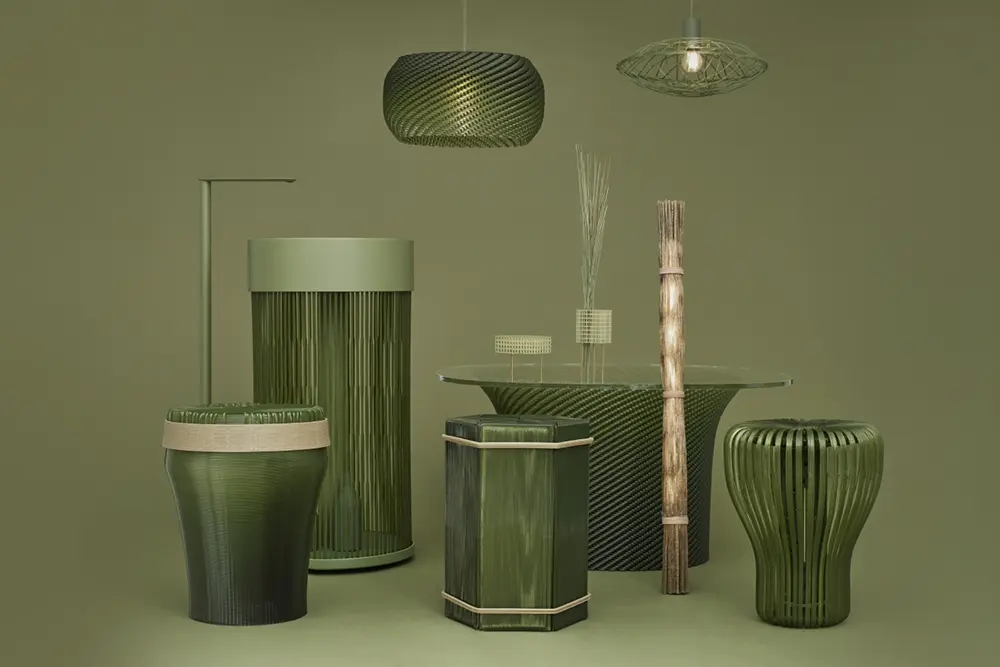 |
Tatami ReFAB | Repurposing and re-embeding tatami mats in modern life in Japan using 3D printing technology. |
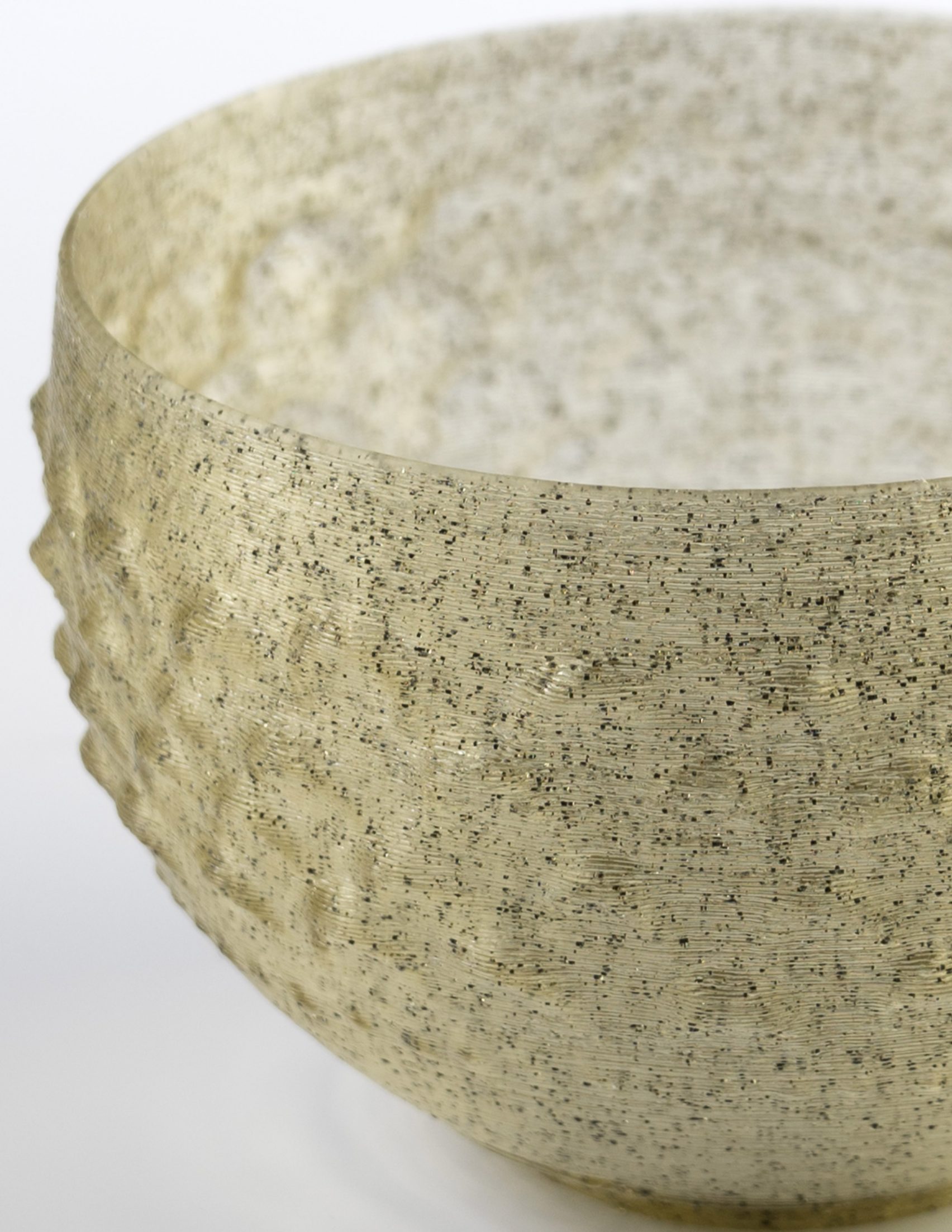 |
Algae Plastics | Using aquatic algae, drying them, and using them in material that can be 3D Printed. |
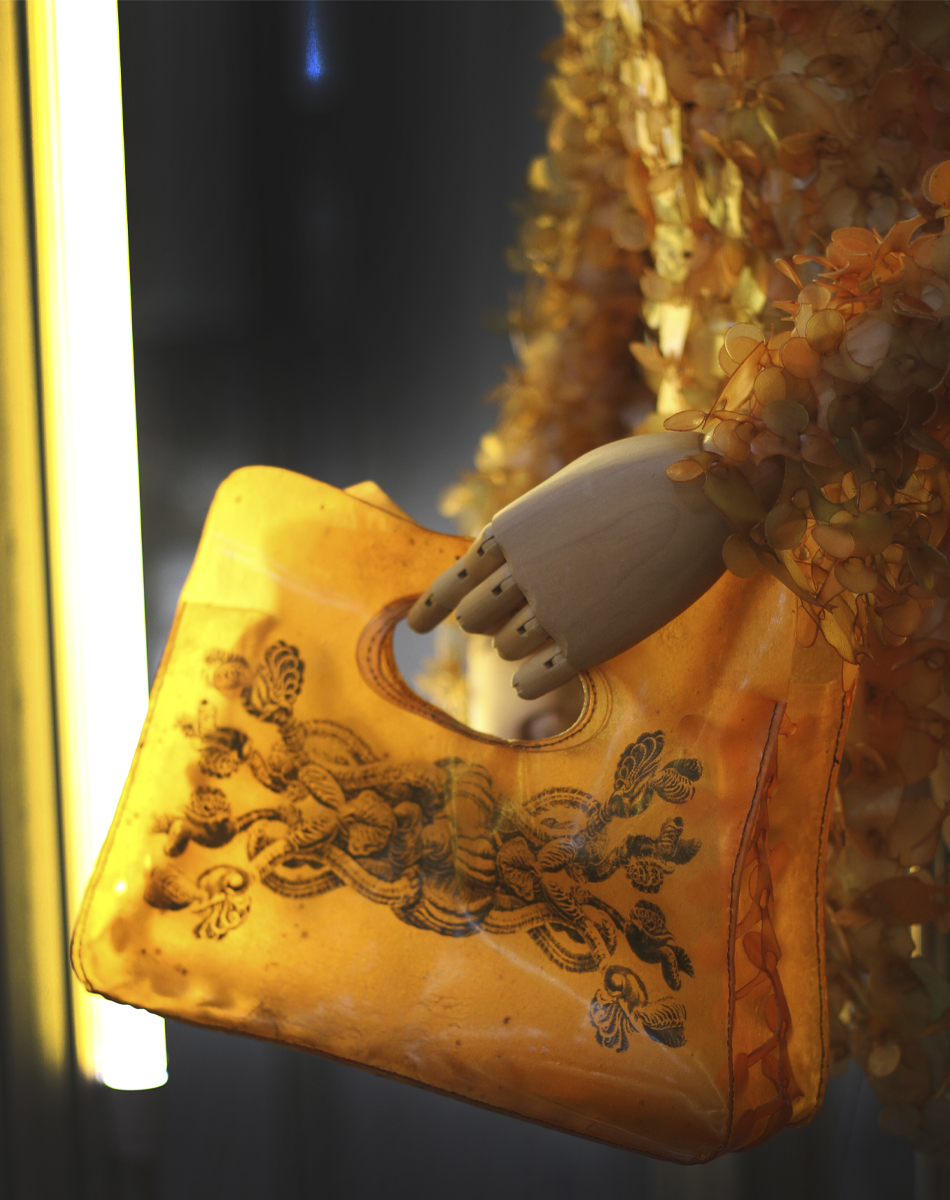 |
Heterotopia | Screenprinting on lasercut carrot leather bag. |
_Standard Recipes¶
_Sodium Alginate¶
"The sodium salt from alginic acid and gum mainly extracted from the cell walls of brown algae. Brown seaweeds are usually larfe, and range from the giant kelp that is often 20m long, to thick, leather-like seaweeds from 2 - 4m long, to smaller species 30 - 60cm long." (Credit Material Archive TextileLab Amsterdam)
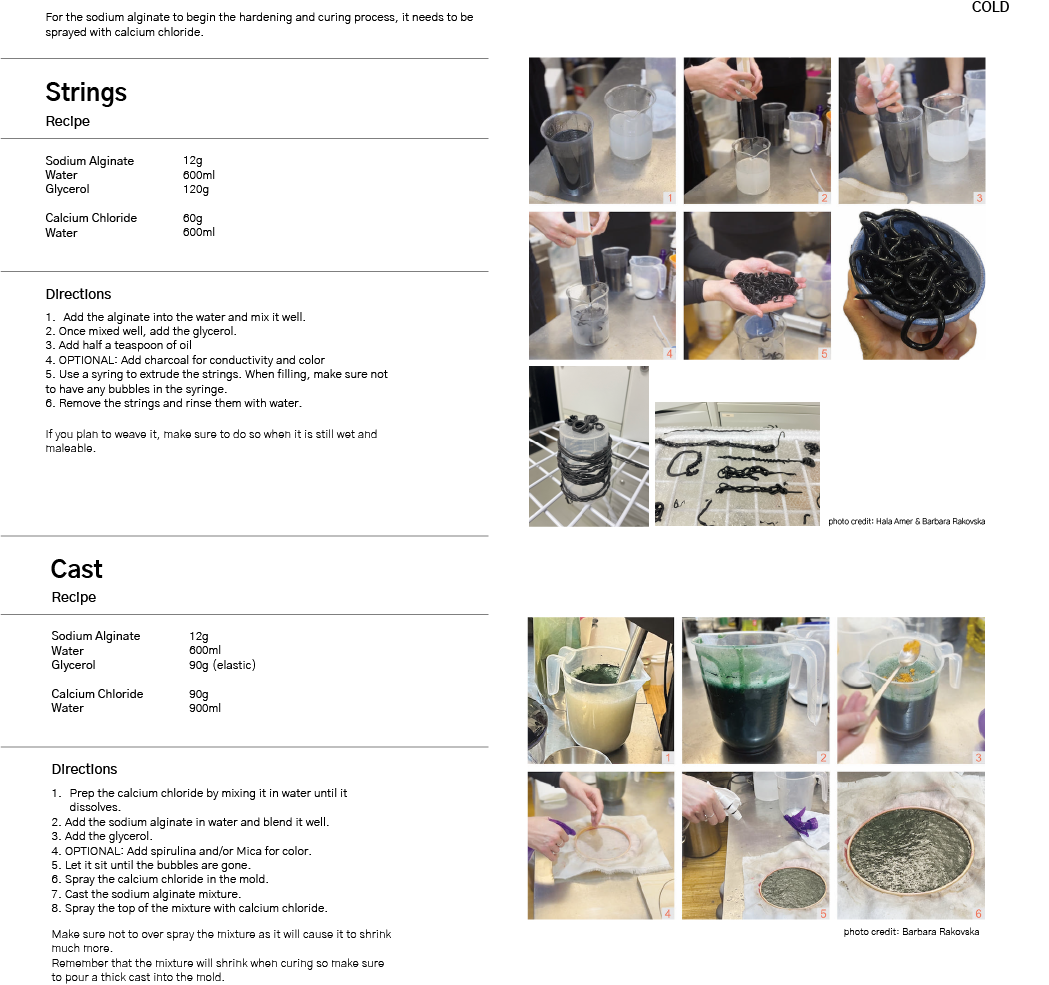
Special Characteristics¶
| Water Resistance | Sodium Alginate becomes water proof! Will only dissolve in alkaline water. |
| Heat Resistance | Withstands temperatures up to 150 degrees celsius. |
Alginate Recipes // Global Lecture
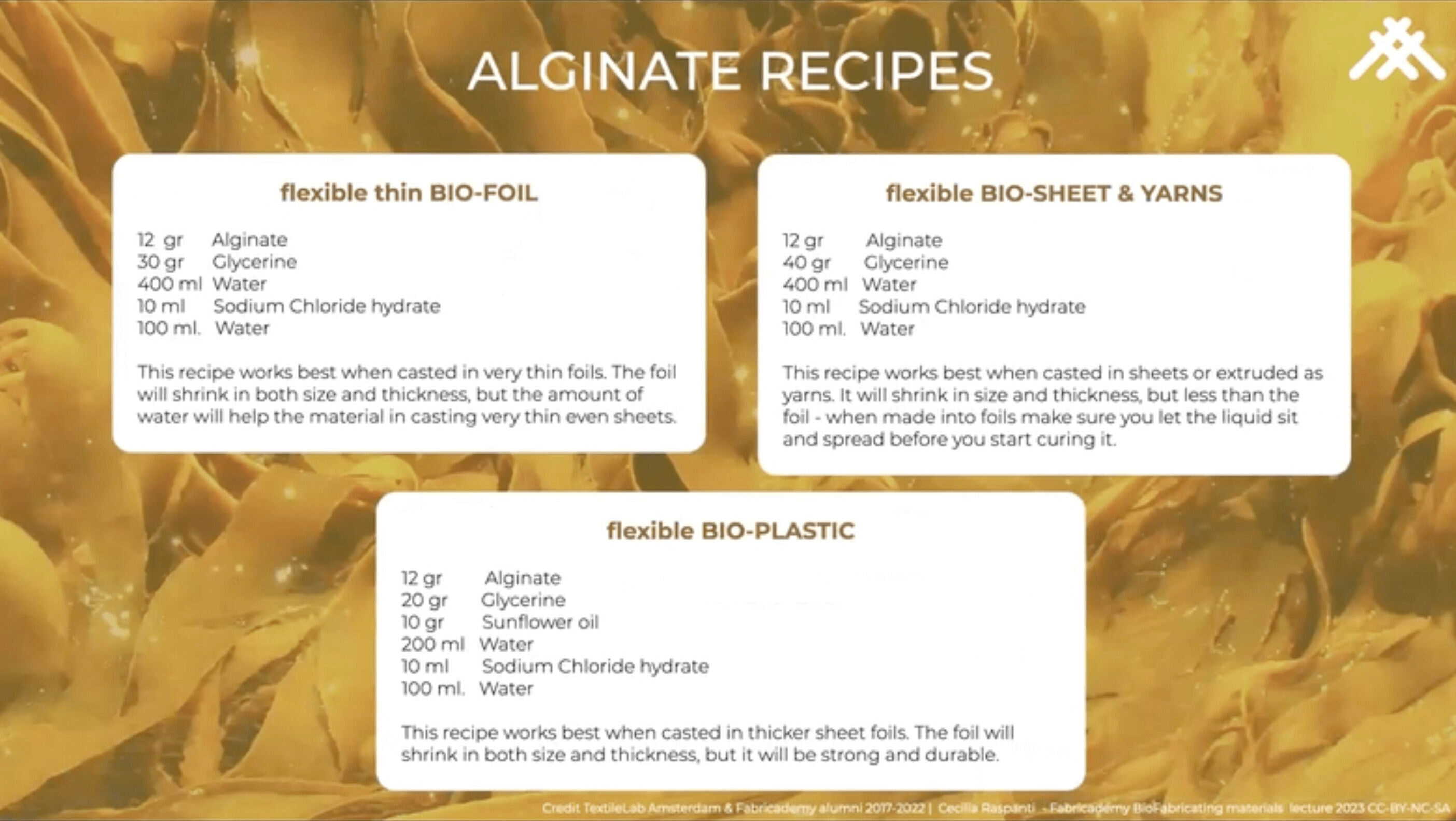
Top two recipes will remain transparent even with pigments and the bottom will become matte.
_Gelatine¶
Animal derived ingredient made from collagen present in animal parts.
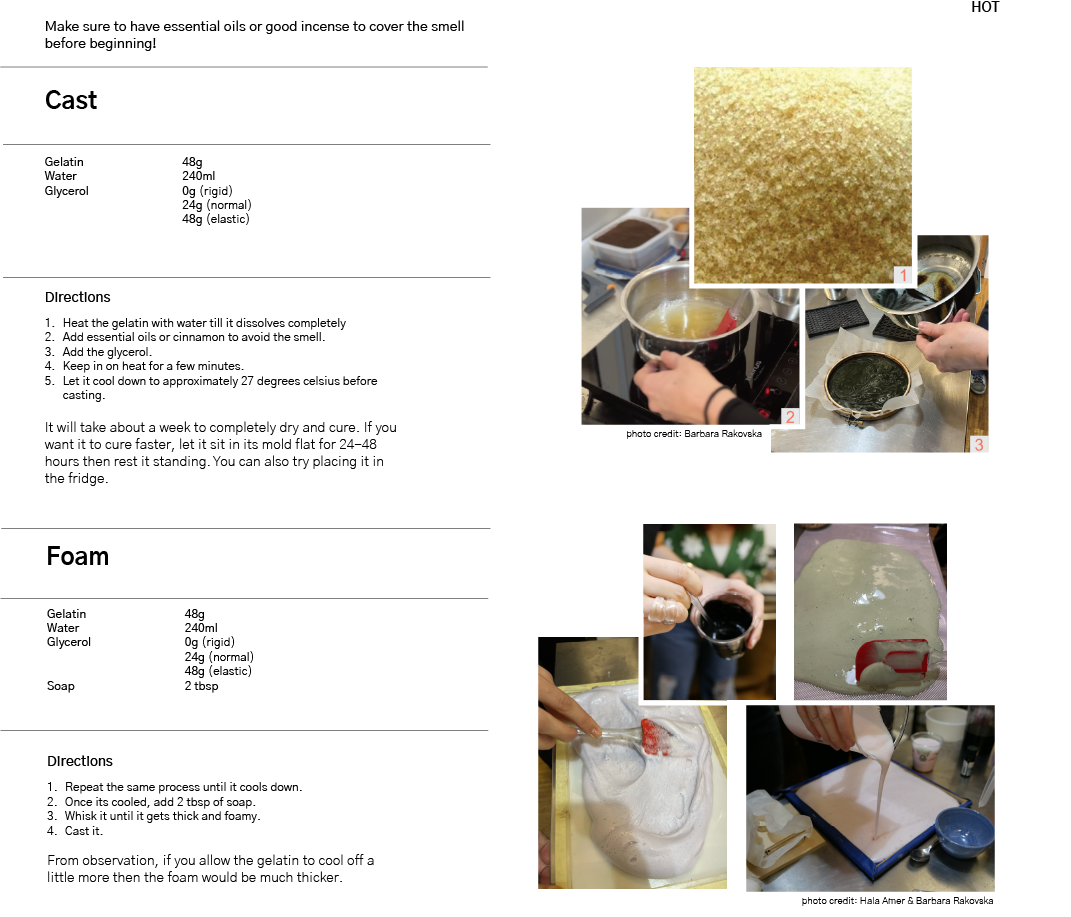
Special Characteristic:¶
| Water Resistance | Takes a couple of hours before dissolving in water. |
| Heat Resistance | Not heat resistant at all. Begins melting at 50 degrees celsius. |
Gelatine Recipes // Global Lecture
Recasting gelatine that has already cured makes more stable materials.

_Agar Agar¶
A jelly-like substance obtained from red algae. "Agar is a mixture of two components: the linear polysaccharide agarose, and a heterogenous mixture of smaller molecules called agaropectin. Agar is a compoind known as a polysaccharide." (Credit Material Archive TextileLab Amsterdam)

Special Characteristic:¶
| Water Resistance | It dissolves in room temperature water in a few hours and hot water immediately. |
| Heat Resistance | Not heat resistant. Best for short term use. |
Agar Recipes // Global Lecture
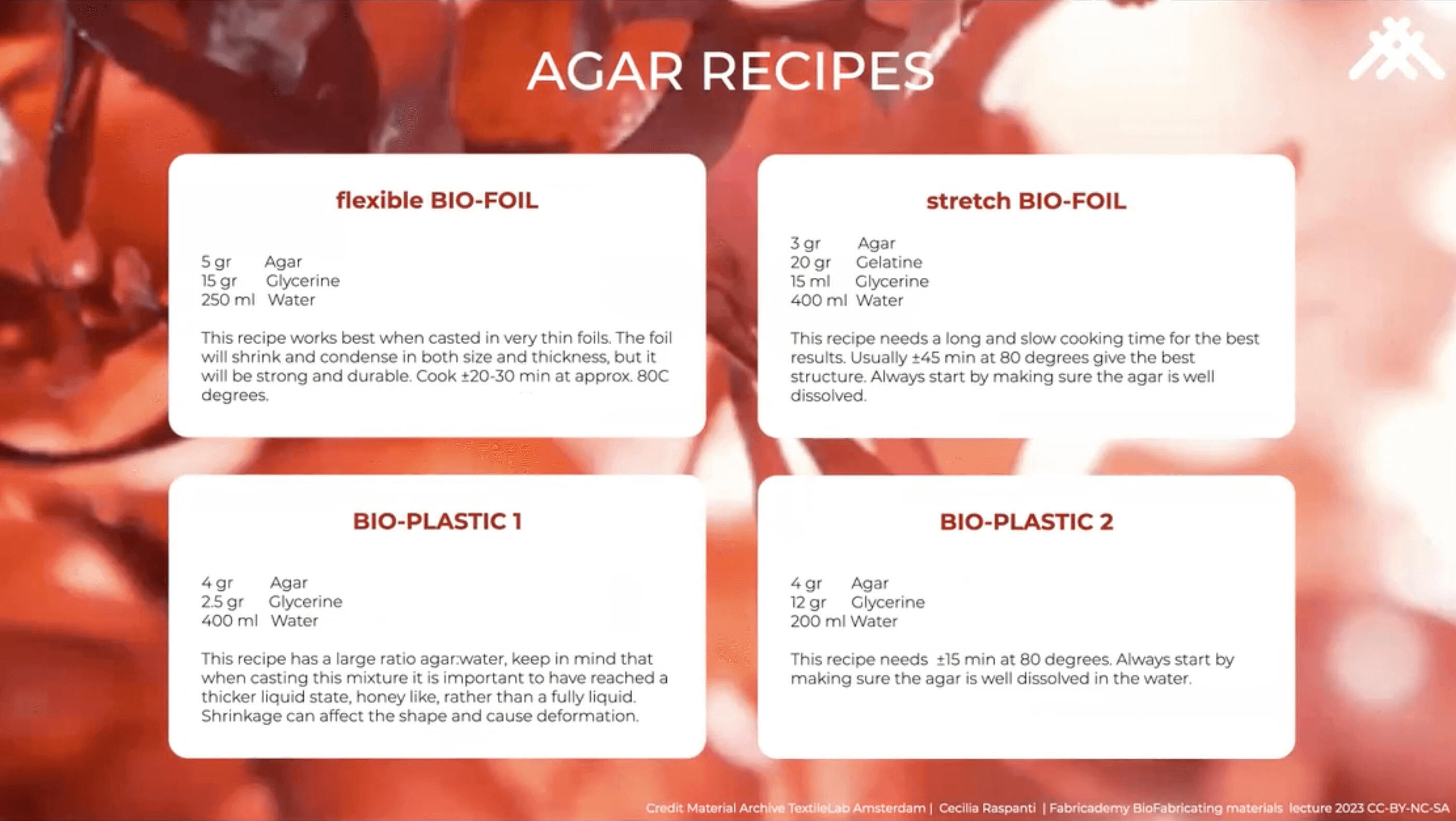
Some tips, Agar can be casted in very thin films, resembling plastic foils. It can never be elastic but it is flexible. (Credit Material Archive TextileLab Amsterdam)
_Resin¶
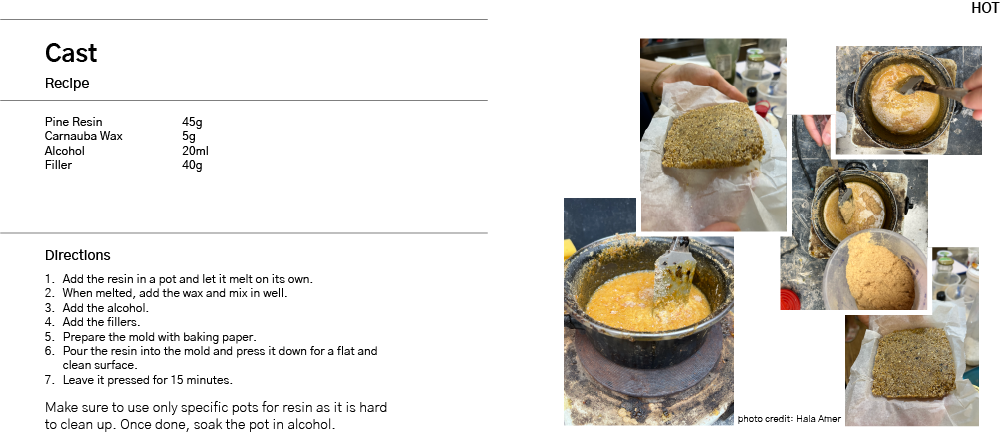
_Leather¶
Carrot Leather

Banana Leather
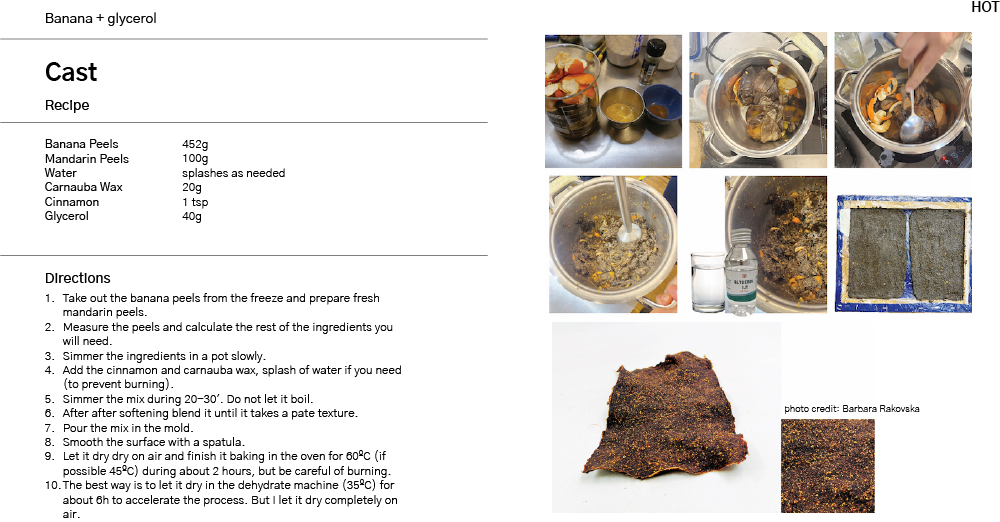
Mushroom Leather

_Mycelium¶
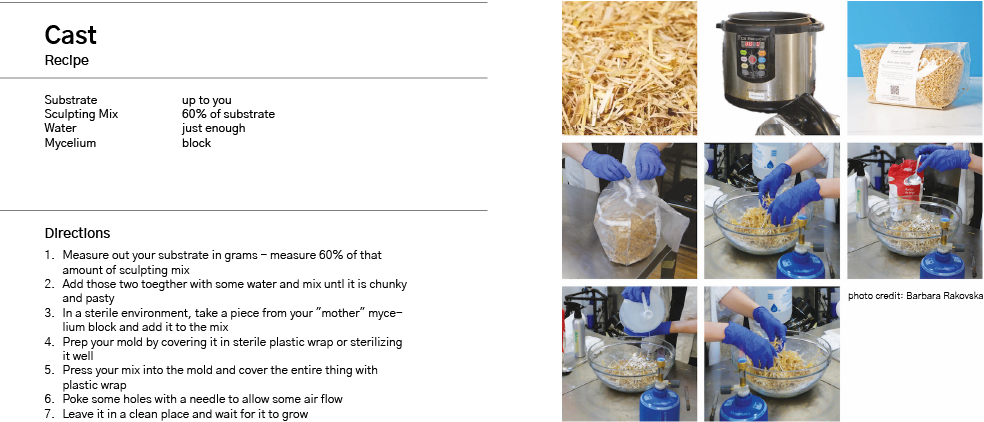
_Overview material research outcomes¶
Agar Agar // Stretch Foil¶
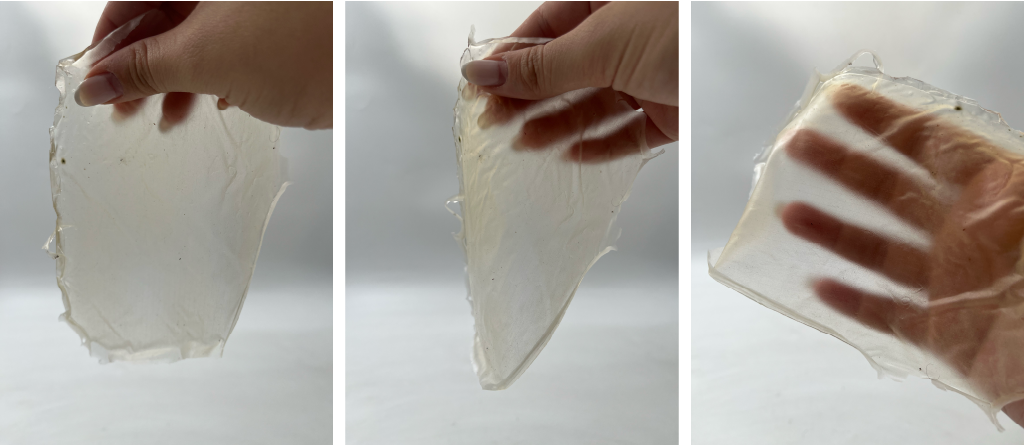 Using the stretch Bio-Foil recipe from the Global Lecture and pouring out a think layer.
Using the stretch Bio-Foil recipe from the Global Lecture and pouring out a think layer.
main experimenter: Hala Amer¶
Agar Agar // Flexible Foil¶
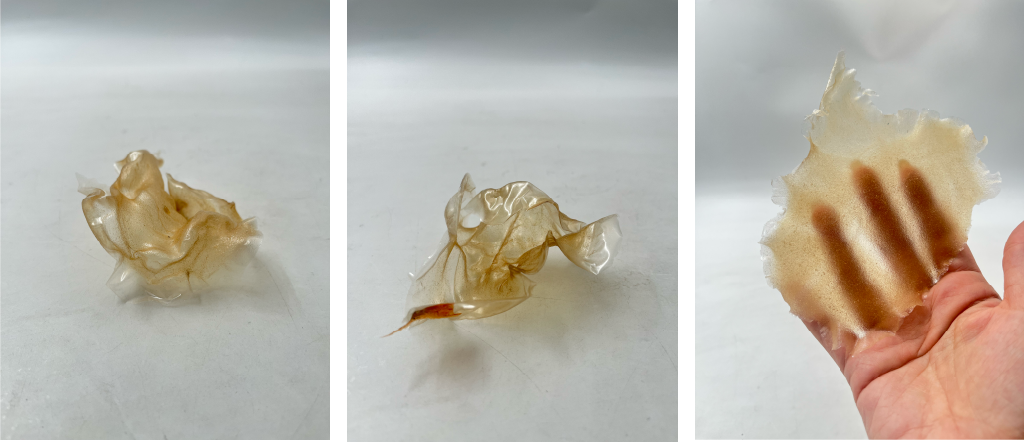 Using the flexible Bio-Foild recipe from the Global Lecture. Starting with no glycerol until 6g of glycerol (left to right).
Using the flexible Bio-Foild recipe from the Global Lecture. Starting with no glycerol until 6g of glycerol (left to right).
main experimenter: Hala Amer¶
Agar agar // Glycerol¶
 Based on recipe above, but in or to achieve "super elastic", add 48g Glycerol (initially elastic one 32g Glycerol), lay it on a flexible plastic sheet and try shaping it by rolling while it's partially dry.
Based on recipe above, but in or to achieve "super elastic", add 48g Glycerol (initially elastic one 32g Glycerol), lay it on a flexible plastic sheet and try shaping it by rolling while it's partially dry.
main experimenter: ChungHan Lu¶
Agar agar // Glycerol¶
 Based on recipe above, but in or to achieve "super elastic", added 48g Glycerol (initially elastic one 32g Glycerol), cast with the mold.
Based on recipe above, but in or to achieve "super elastic", added 48g Glycerol (initially elastic one 32g Glycerol), cast with the mold.
main experimenter: ChungHan Lu¶
Agar Agar // Sawdust // Pressed¶
 Recipe above for Agar Agar with sawdust added. Spread in even layer with circular moulds placed on top and pushed in for whole drying process.
Recipe above for Agar Agar with sawdust added. Spread in even layer with circular moulds placed on top and pushed in for whole drying process.
main experimenter: Ruby Lennox¶
Agar Agar // Eggshells¶
 Letting the agar become more viscous before adding the eggshells into the mixture. Puring it on a circular wooden surface and allowing it to dry on it.
Letting the agar become more viscous before adding the eggshells into the mixture. Puring it on a circular wooden surface and allowing it to dry on it.
main experimenter: Hala Amer¶
Agar Agar // Foam¶
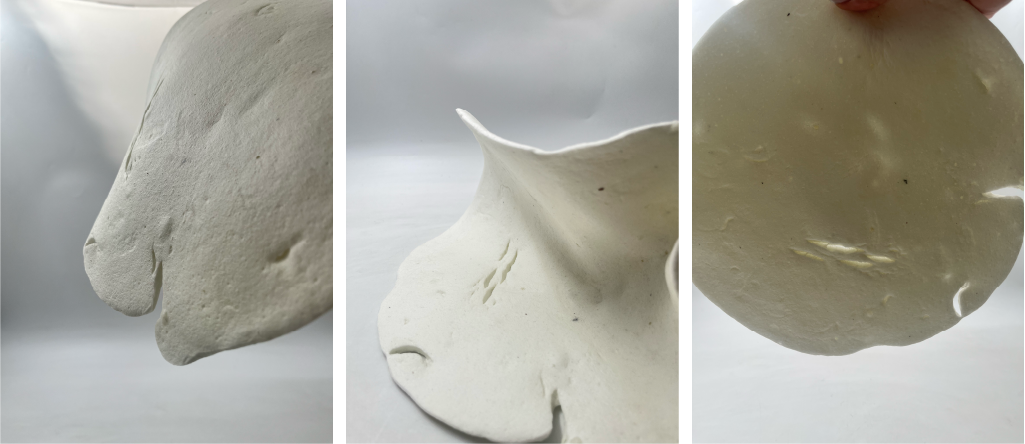 Whisking the regular agar recipe with soap to make a foam.
Whisking the regular agar recipe with soap to make a foam.
main experimenter: Hala Amer¶
Gelatin // Glycerol // Cabbage pigment¶
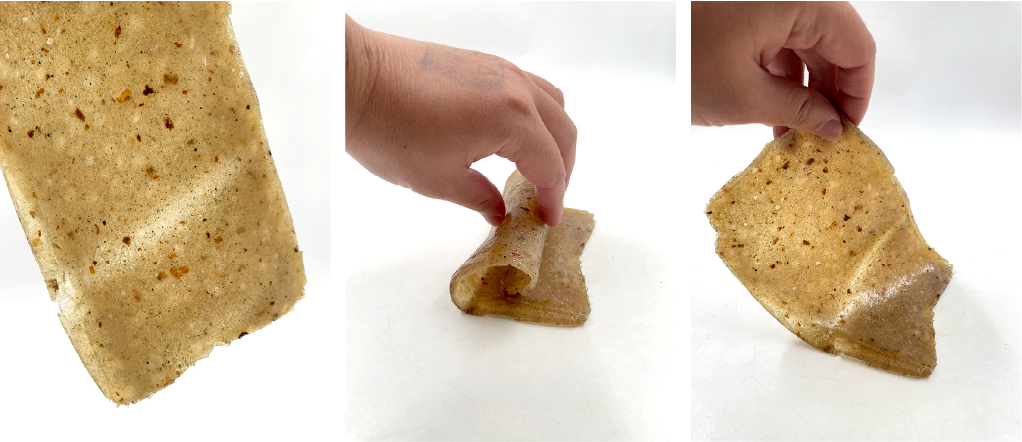 Recipe above(elstice one), added caggage pigment from Biochorme week. Unexpectedly, there were some burnt gelatin residues left at the bottom of the pot that got mixed into the new material during cooking. The dye's color isn't very pronounced, but these burnt gelatin substances added a new texture.
Recipe above(elstice one), added caggage pigment from Biochorme week. Unexpectedly, there were some burnt gelatin residues left at the bottom of the pot that got mixed into the new material during cooking. The dye's color isn't very pronounced, but these burnt gelatin substances added a new texture.
main experimenter: ChungHan Lu & Barbara Rakovská¶
Gelatin // Glycerol // Embedded Textile¶
 Recipe above(elstice one), try to combining different materials, hoping that the external textile would interact with the gelatin bioplastic. Pour in the mold like a "sandwich": starting with one layer of material, then placing the textile, and finally adding another layer of material.
Recipe above(elstice one), try to combining different materials, hoping that the external textile would interact with the gelatin bioplastic. Pour in the mold like a "sandwich": starting with one layer of material, then placing the textile, and finally adding another layer of material.
main experimenter: ChungHan Lu¶
Gelatin // Glycerol // Embedded Textile¶
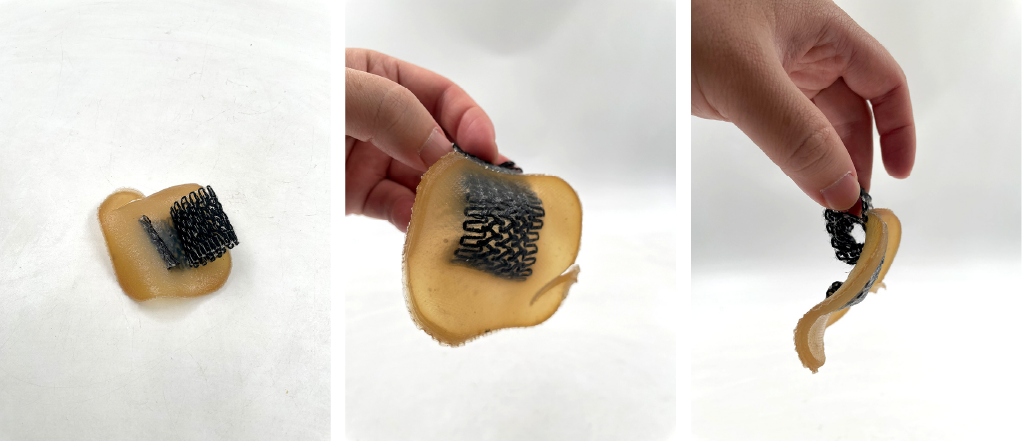 Recipe above(elstice one), was useing the textile as the main material(structure), gelatin bioplastic as a coating, resulting in a thin, transparent layer on the textile.
Recipe above(elstice one), was useing the textile as the main material(structure), gelatin bioplastic as a coating, resulting in a thin, transparent layer on the textile.
main experimenter: ChungHan Lu¶
Gelatine // Foam // Flexible // Dye Bath¶
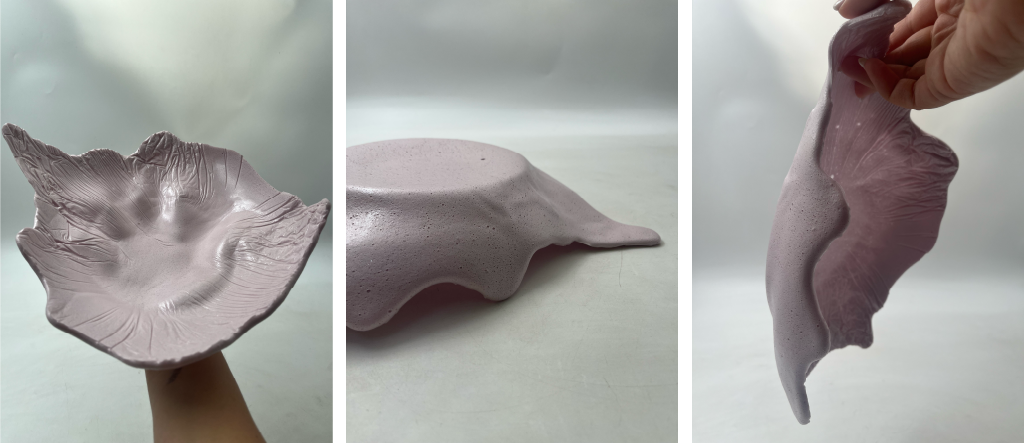 Using a dye bath instead of regular water and making a flexible gelatine mixture. Once cooled down, its whisked to create a foam.
Using a dye bath instead of regular water and making a flexible gelatine mixture. Once cooled down, its whisked to create a foam.
main experimenter: Hala Amer¶
Gelatine // Foam // Cabbage Dye Bath // Strings¶
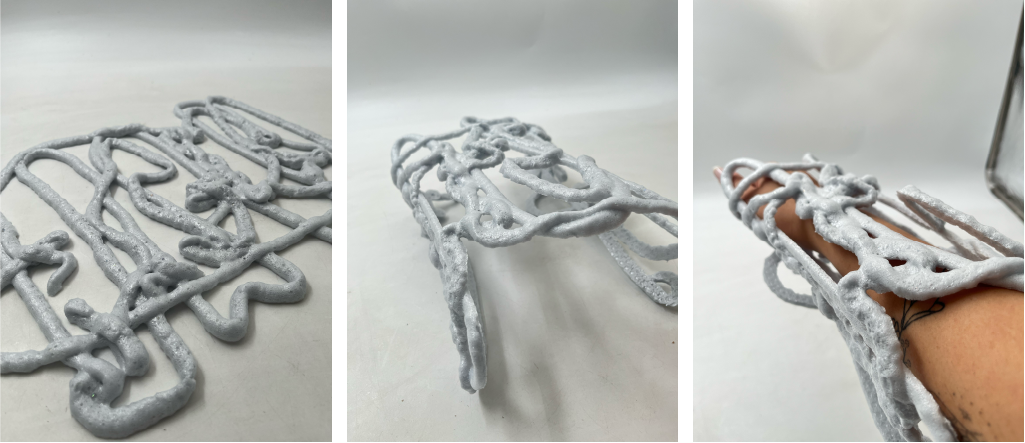 Using a dye bath instead of regular water and making a flexible gelatine mixture. Once cooled down, its whisked to create a foam.
Using a dye bath instead of regular water and making a flexible gelatine mixture. Once cooled down, its whisked to create a foam.
Using less Glycerol, 10g to 400ml of water.
Using a plastic bag, pouring it out strings in shapes.
main experimenter: Hala Amer¶
Gelatine // Foam // Cabbage Dye Bath¶
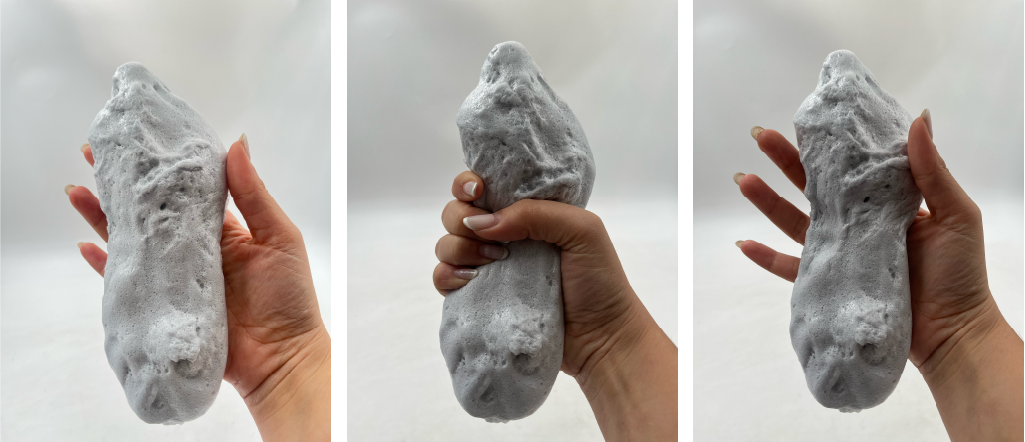 Using a dye bath instead of regular water and making a flexible gelatine mixture. Once cooled down, its whisked to create a foam.
Using a dye bath instead of regular water and making a flexible gelatine mixture. Once cooled down, its whisked to create a foam.
Using less Glycerol, 10g to 400ml of water.
Pouring out a large blob. Resembles memory foam and goes back to shape in a few minutes.
main experimenter: Hala Amer¶
Gelatine // Foam // Rigid¶

main experimenter: Julija Karas¶
Gelatine // Foam // Soap // Rigid¶
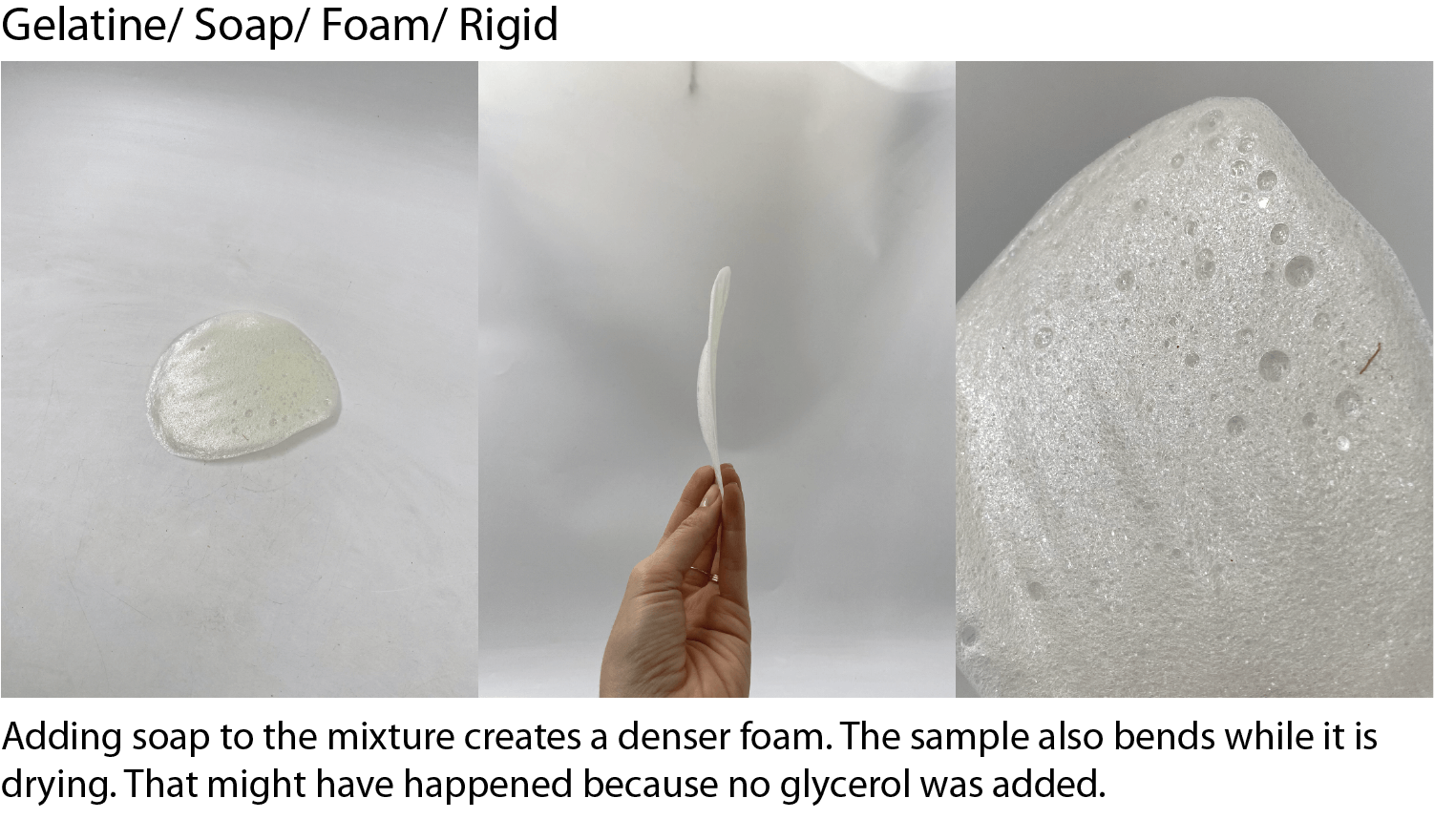
main experimenter: Julija Karas¶
Gelatine // Foam // Soap // Soft // Glycerol¶

main experimenter: Julija Karas¶
Gelatine // Foam // Soap // Soft // Glycerol¶

main experimenter: Julija Karas¶
Gelatine // Foam // Soap // Soft // Glycerol¶
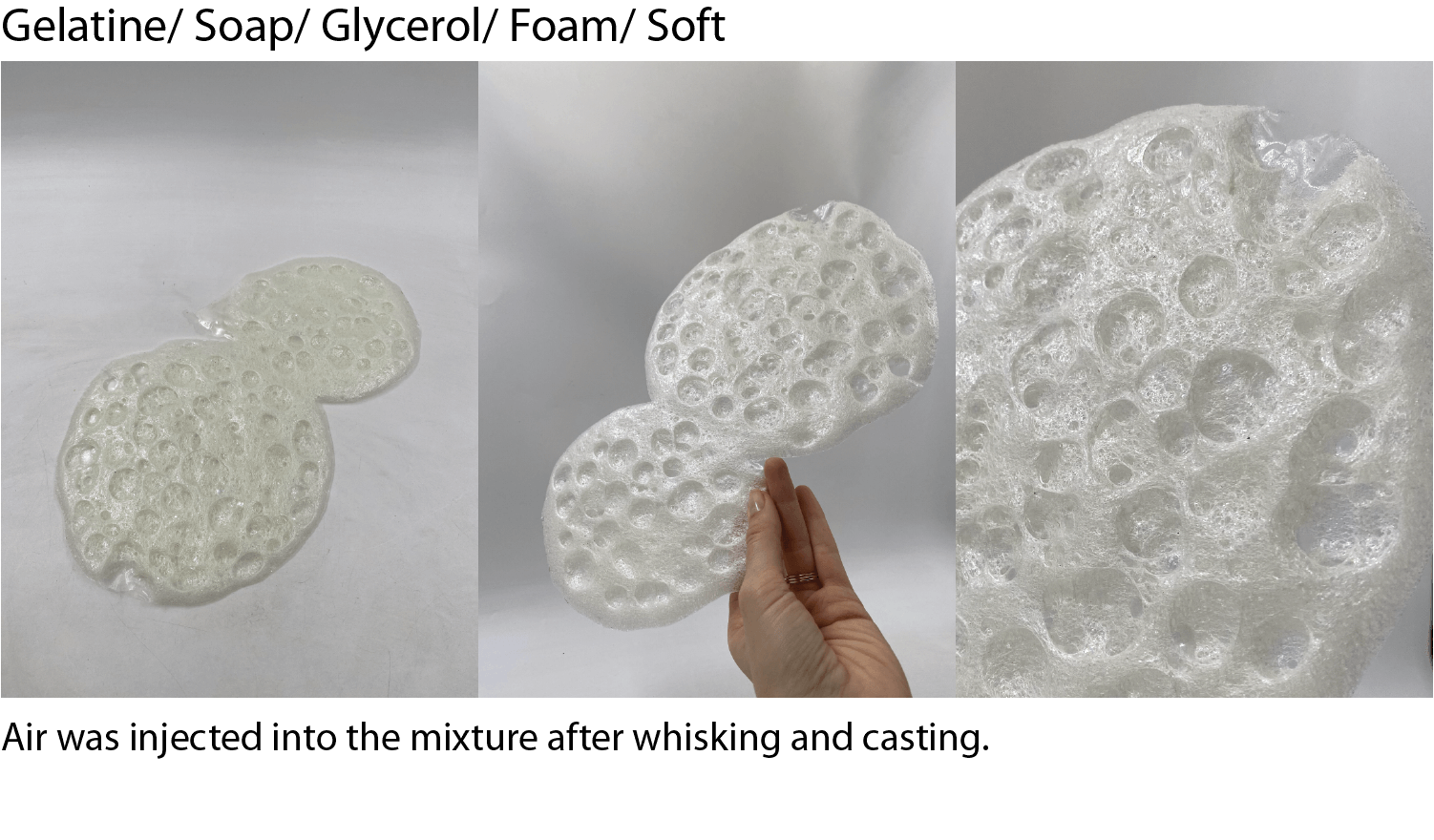
main experimenter: Julija Karas¶
Gelatine // Foam // Charcoal¶
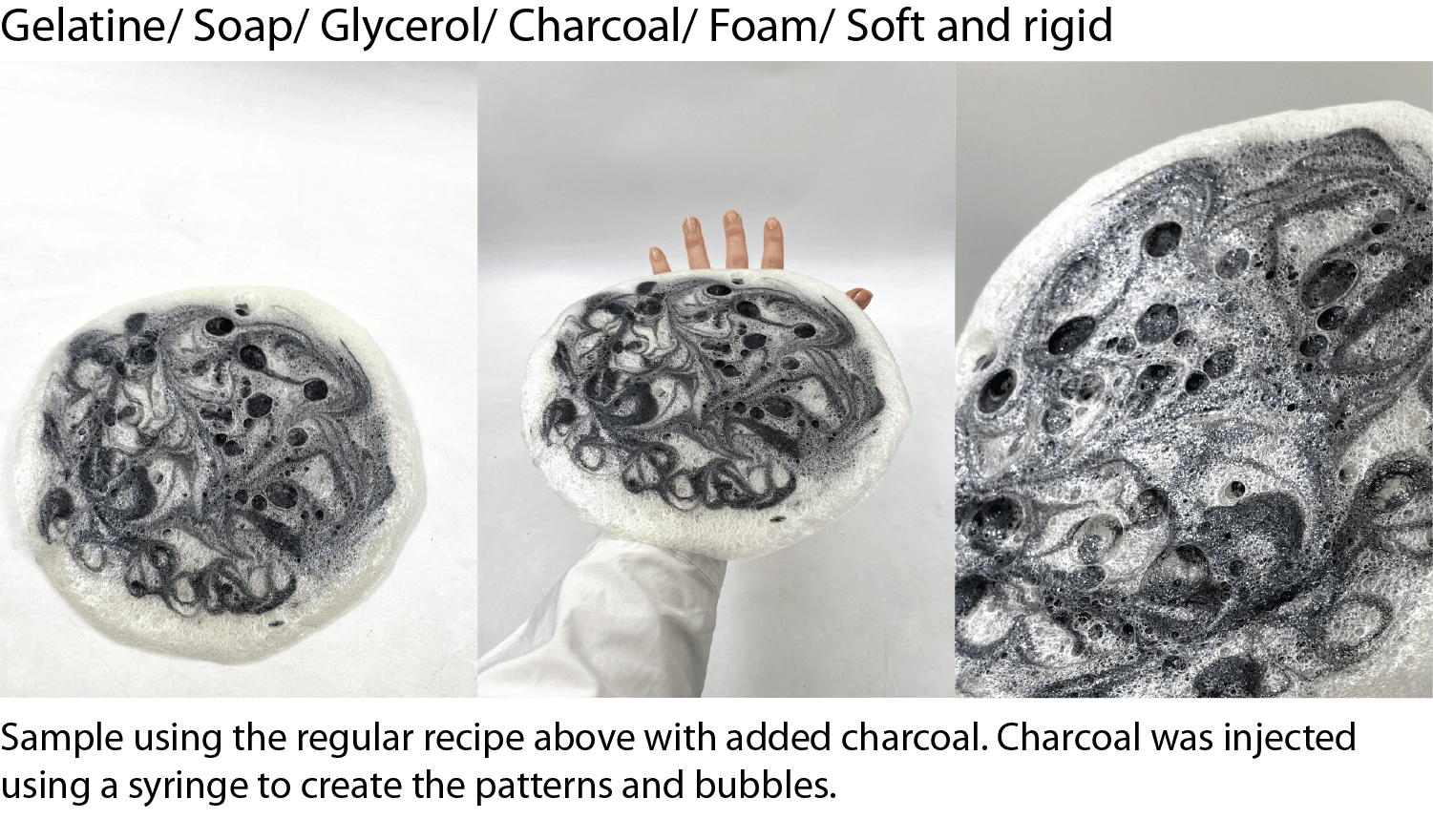
main experimenter: Julija Karas¶
Gelatine // Foam // Charcoal¶
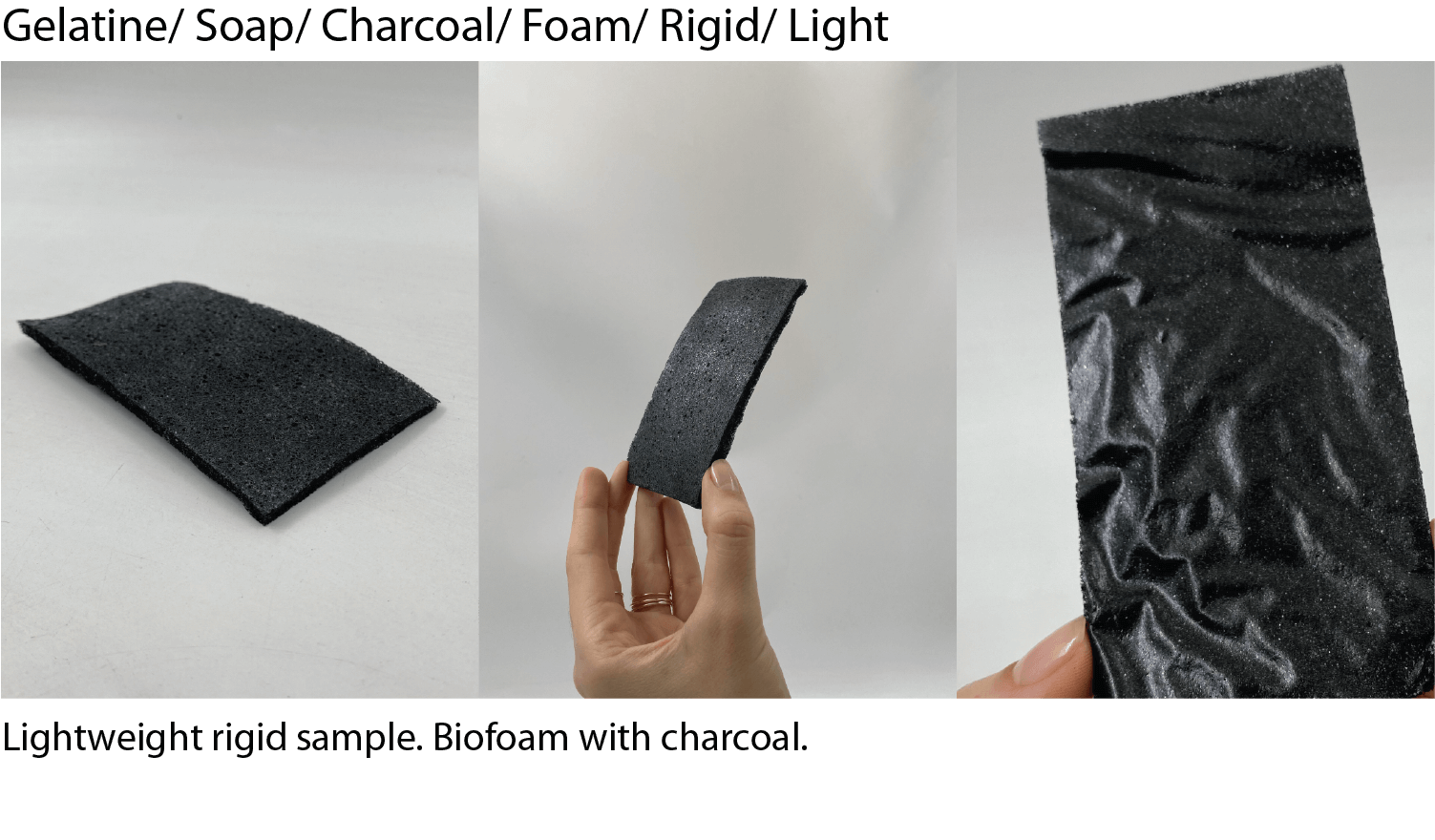
main experimenter: Julija Karas¶
Gelatine // Foam // Charcoal¶

main experimenter: Julija Karas¶
Gelatine // Foam // Wool¶
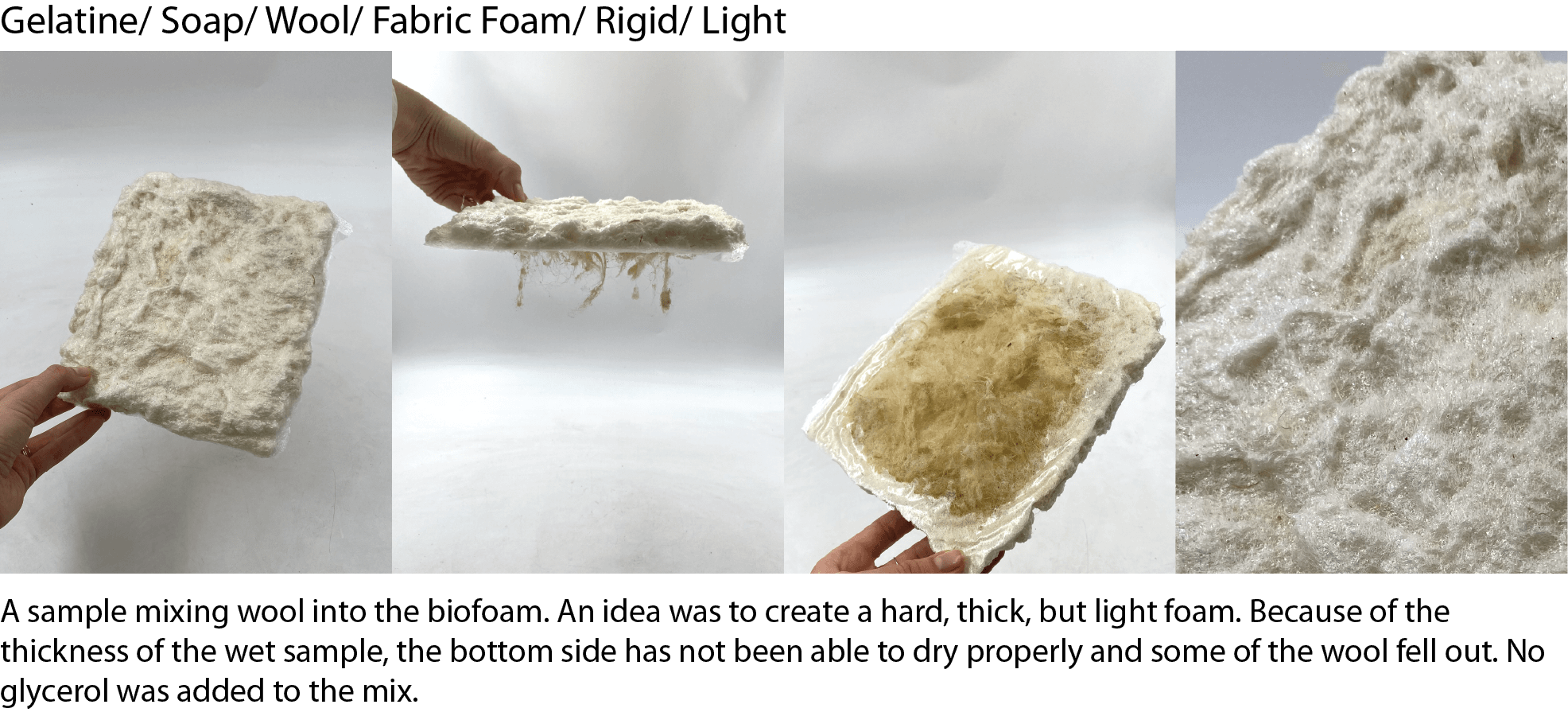
main experimenter: Julija Karas¶
Gelatine // Foam // Wool // Charcoal¶
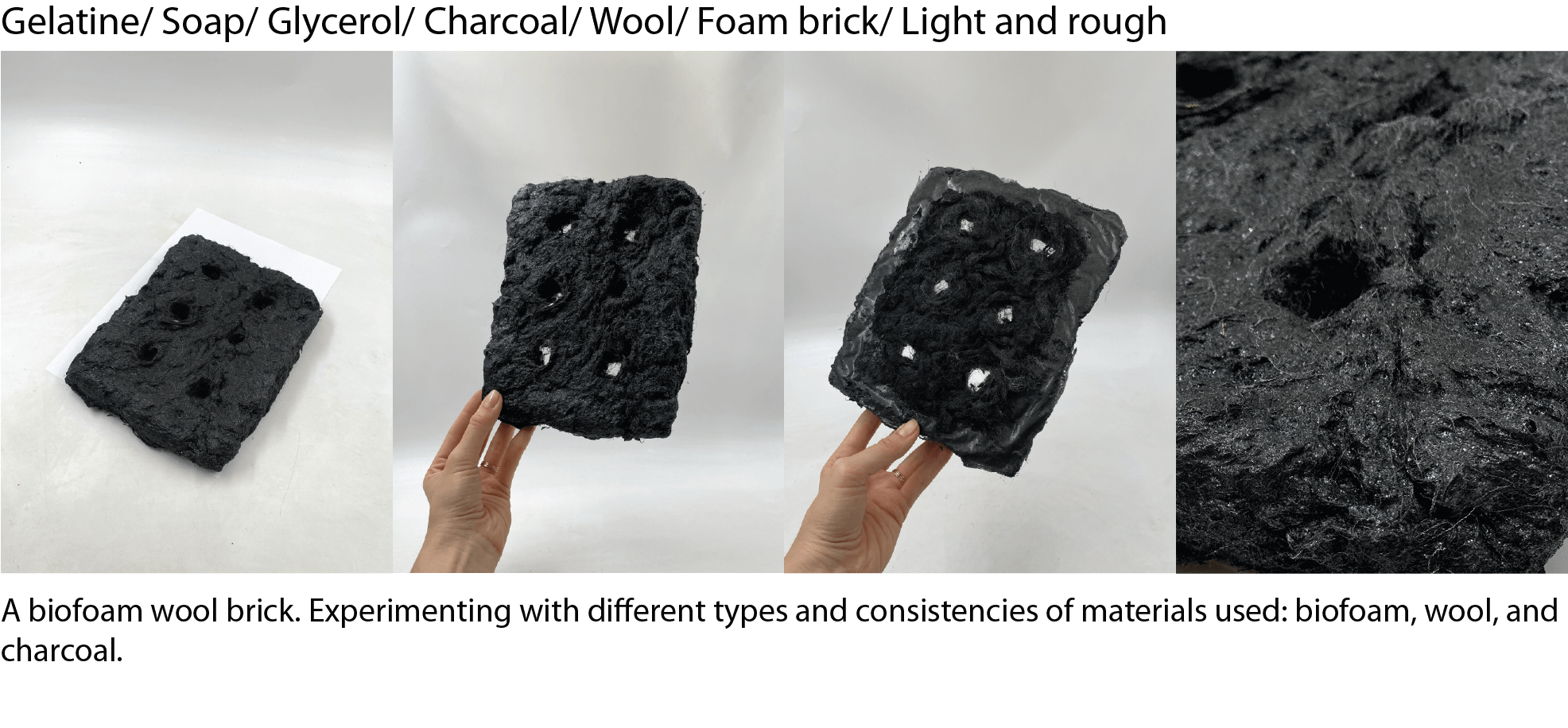
main experimenter: Julija Karas¶
Gelatine // Defraction¶

main experimenter: Julija Karas¶
Alginate // Dye Bath // Woven¶
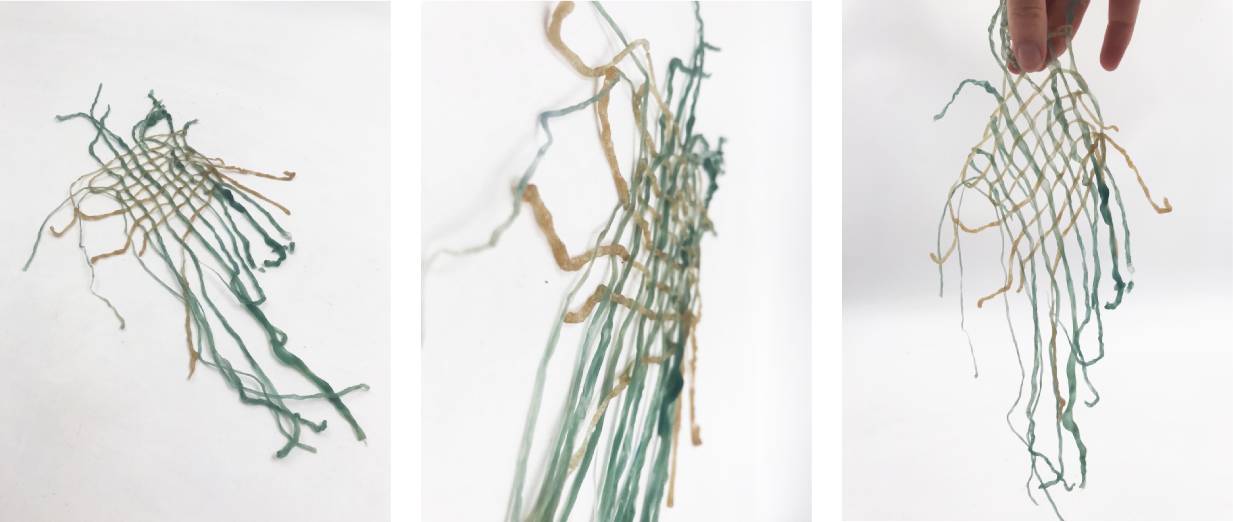 Recipe above for extruded alginate with dye bath from beetroot added for pink and from cabbage for blue strings. Woven while strings are wet.
Recipe above for extruded alginate with dye bath from beetroot added for pink and from cabbage for blue strings. Woven while strings are wet.
main experimenter: Ruby Lennox¶
Alginate // Dye Bath // Knit¶
 Recipe above for extruded alginate with dye bath from beetroot added. Knit while wet.
Recipe above for extruded alginate with dye bath from beetroot added. Knit while wet.
main experimenter: Ruby Lennox¶
Alginate // Charcoal // Knit¶
 Recipe above for extruded alginate with charcoal added. Knit into chain while wet.
Recipe above for extruded alginate with charcoal added. Knit into chain while wet.
main experimenter: Ruby Lennox¶
Alginate // Sawdust¶
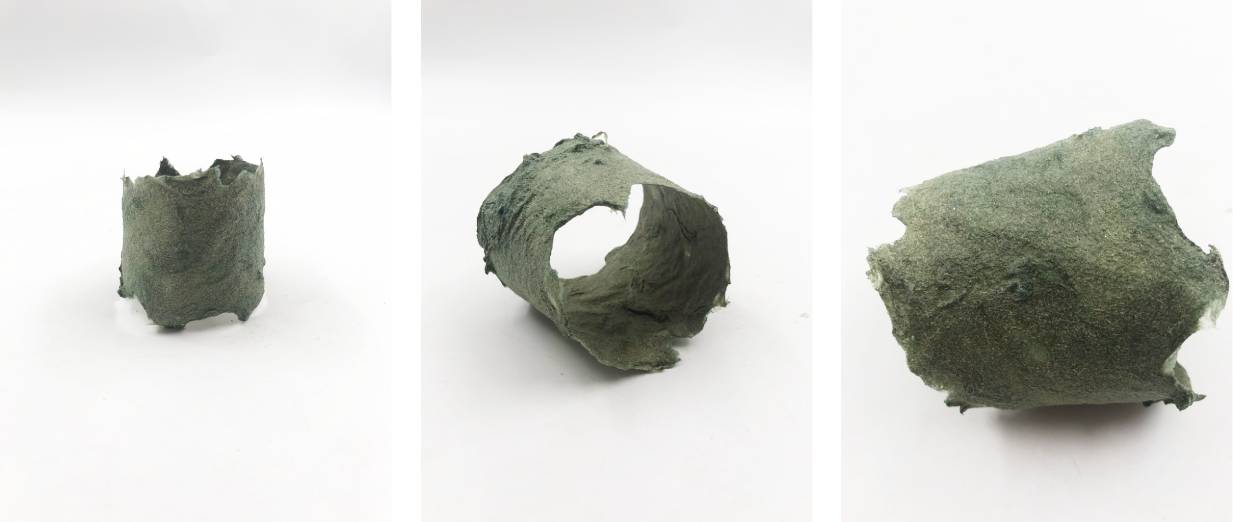 Recipe above for alginate mixed about 10:8 alginate to sawdust. Moulded around a glass while wet.
Recipe above for alginate mixed about 10:8 alginate to sawdust. Moulded around a glass while wet.
main experimenter: Ruby Lennox¶
Alginate // Sawdust // Layering¶
 Recipe above for alginate. Layers or alginate in different shapes covered in sawdust between each layer then sprayed with calcium chloride.
Recipe above for alginate. Layers or alginate in different shapes covered in sawdust between each layer then sprayed with calcium chloride.
main experimenter: Ruby Lennox¶
Alginate // Molded¶
 Recipe above for alginate painted in a very thin layer then sprayed with calcium chloride and reshaped while gelling.
Recipe above for alginate painted in a very thin layer then sprayed with calcium chloride and reshaped while gelling.
main experimenter: Ruby Lennox¶
Alginate // Layering¶
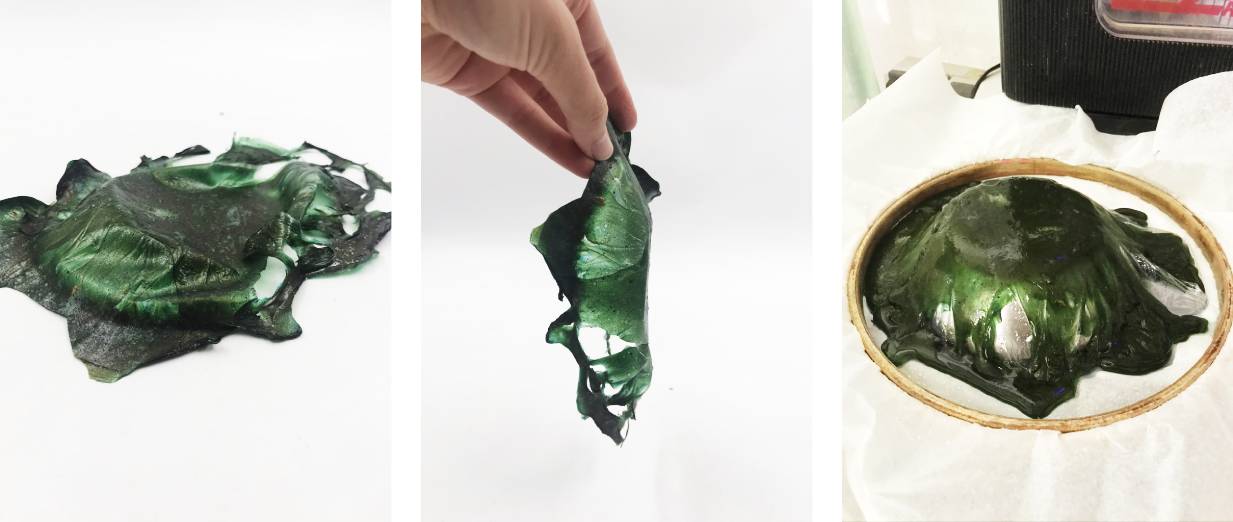 Recipe above for alginate. Multiple layers poured over a bowl mould with calcium chloride spared in between each layer.
Recipe above for alginate. Multiple layers poured over a bowl mould with calcium chloride spared in between each layer.
main experimenter: Ruby Lennox¶
Alginate // Foam // Charcoal¶
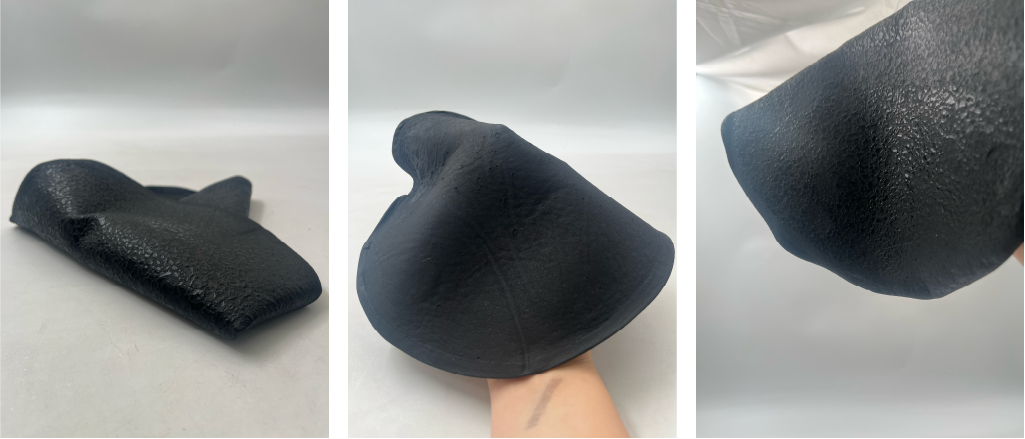 Adding charcoal to the sodium alginate mixture. After allowing it to cool, whisking it to make foam.
Adding charcoal to the sodium alginate mixture. After allowing it to cool, whisking it to make foam.
main experimenter: Hala Amer & Julija Karas¶
Alginate // Foam // Spirulina¶
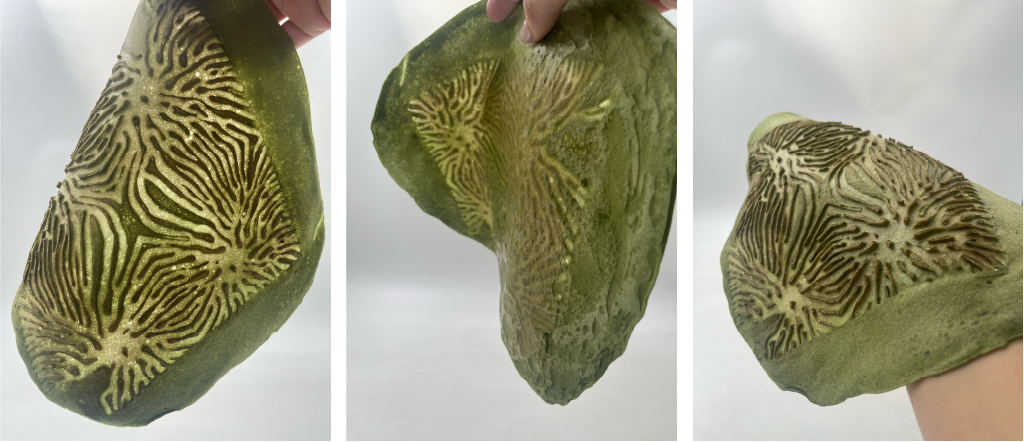 Adding spirulina to the sodium alginate mixture. After allowing it to cool, whisking it to make foam. Once casted, a lasercut pattern is placed on top to get the shape.
Adding spirulina to the sodium alginate mixture. After allowing it to cool, whisking it to make foam. Once casted, a lasercut pattern is placed on top to get the shape.
main experimenter: Hala Amer & Julija Karas¶
Leather // Carrot // Sodium Alginate¶
 Recipe above. Chopped carrots with sodium alginate mixture with glycerol for flexibility.
Recipe above. Chopped carrots with sodium alginate mixture with glycerol for flexibility.
main experimenter: Hala Amer¶
Pine resin // Carnauba wax // Alcohol // Saw dust¶
 Recipe above, but would like to keep more translucency, so added less filler.
Recipe above, but would like to keep more translucency, so added less filler.